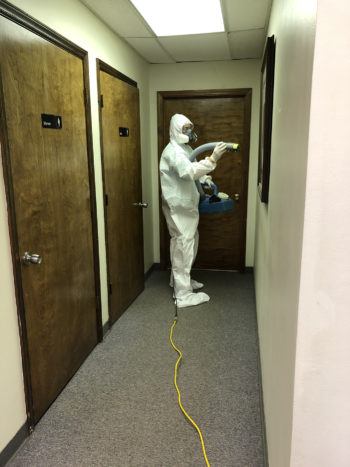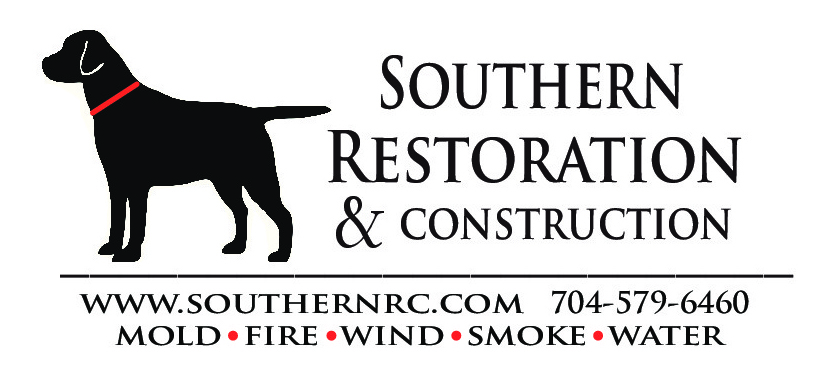With the Global Pandemic of the Coronavirus or COVID-19, many are trying to find the best ways possible to plan for the unknown and protect themselves from any infectious disease. Business owners and employees alike are wanting to feel safe in their work environments knowing that all steps have been taken to insure their health.
COVID-19 is similar to SARS in the aspect that both are a coronavirus. Our company of restoration professionals has access to the best professional-grade antimicrobial and antibacterial products that can both clean and sanitize your office environment, no matter what kind of facility you may have. These procedures along with the most up-to-date products and processes set forth by the CDC will give you and your staff a level of comfort that you wouldn’t have had otherwise that the most that can be done has been completed.
Being proactive on the sanitizing and decontamination of your environment by having a professional restoration/remediation company to perform a deep cleaning/sanitizing/
Southern Restoration & Construction is one of a few companies in the greater Charlotte area that has the solutions, equipment and professional manpower to handle this threat. Contact us immediately to perform a deep clean and sanitization of your work environment.
GENERAL INFORMATION REGARDING COVID-19
- Coronaviruses (CoV) are a large family of viruses that cause illness ranging from the common cold to more severe diseases such as Middle East Respiratory Syndrome (MERS-CoV) and Severe Acute Respiratory Syndrome (SARS-CoV).
- Coronavirus disease (COVID-19) is a new strain that was discovered in 2019 and has not been previously identified in humans.
- Coronaviruses are zoonotic, meaning they are transmitted between animals and people. Detailed investigations found that SARS-CoV was transmitted from civet cats to humans and MERS-CoV from dromedary camels to humans. Several known coronaviruses are circulating in animals that have not yet infected humans.
- Common signs of infection include respiratory symptoms, fever, cough, shortness of breath and breathing difficulties. In more severe cases, infection can cause pneumonia, severe acute respiratory syndrome, kidney failure and even death.
- Standard recommendations to prevent infection spread include regular hand washing, covering mouth and nose when coughing and sneezing, thoroughly cooking meat and eggs. Avoid close contact with anyone showing symptoms of respiratory illness such as coughing and sneezing.

HELPFUL LINKS
How it spreads via the CDC –
https://www.cdc.gov/coronavirus/2019-ncov/prepare/transmission.html
Prevention and Treatment via the CDC –
https://www.cdc.gov/coronavirus/2019-ncov/prepare/prevention.html
Products EPA approves to Disinfect –
https://www.epa.gov/pesticide-registration/list-n-disinfectants-use-against-sars-cov-2
It is important for all parties to understand the different levels of cleaning that may or may not be possible for each surface. All surfaces can be cleaned, many surfaces can be sanitized, and some surfaces can be disinfected.
The three main levels of microbe control are:
-
General surface cleaning – physically removes visible dirt, organic matter, viruses, fungi, and bacteria. General surface cleaning is accomplished with water, detergent, and physical scrubbing of the surface. The guiding principal is to remove microbes if possible, rather than kill them (with a sanitizer or disinfectant). In addition, thoroughly cleaning a surface can reduce the need to disinfect because without the nutrients and moisture needed to survive and multiply, most microbes cannot live on a clean and dry surface for very long.
-
Sanitizing – reduces but does not necessarily eliminate all bacteria on a treated surface. Sanitizers do not have claims for viruses or fungi. To be a registered sanitizer, the test results for a product must show a reduction of at least a 99.9% in the number of each type of bacteria tested on non-food-contact surfaces. Examples of non-food-contact sanitizers include carpet sanitizers, air sanitizers, laundry additives, and in-tank toilet bowl sanitizers.
-
Disinfecting – works by using chemicals to kill germs on surfaces this process does not necessarily clean dirty surfaces or remove germs. Disinfecting destroys or irreversibly inactivates infectious or other undesirable microbes, but not necessarily the spores of bacteria and fungi. The number of microbes killed during a disinfecting process will vary, depending on the specific chemical and how it is used.
Cleanup Scope of Work and Planning
The CDC encourages cleaning of high touch surfaces such as counters, tabletops, doorknobs, bathroom fixtures, toilets, phones, keyboards, tablets, and tables at a minimum. These same surfaces are mentioned in the CDCs guidance for commercial spaces as well. Buildings and spaces greatly differ, each location will require individual planning.
Cleaning removes the soil and dirt that harbors the infectious agents, while disinfecting kills the remaining environmental pathogens. Cleaning of visibly dirty surfaces followed by disinfection is a best practice measure for prevention of COVID-19 and other viral respiratory illnesses in community settings. Both cleaning and disinfecting must be a part of your scope of work and plan.
The cleanup scope is dependent on the type of coronavirus situation.
- High Touch Cleanup: Cleanup of high touch surfaces is required for a situation involving a person who is suspected to have COVID-19 or a Person Under Investigation (PUI); which is someone who is involved in a quarantine situation or has come in contact with someone who has been in a quarantine situation, or has come in contact with someone testing positive. This includes cleaning and disinfecting of high touch nonporous surfaces and cleaning and sanitizing of high touch porous surfaces.
- Enhanced Cleanup: Enhanced cleanup is required for an area in which a person who has been confirmed positive for COVID-19 has inhabited. This includes cleaning and disinfecting of all nonporous surfaces and cleaning and sanitizing of all porous surfaces. This enhanced cleaning includes walls up to 8 feet but excludes ceilings.
- A combination of High Touch Cleanup and Enhanced Cleanup may be needed within a structure based on where the infected individual has directly traveled or occupied.
